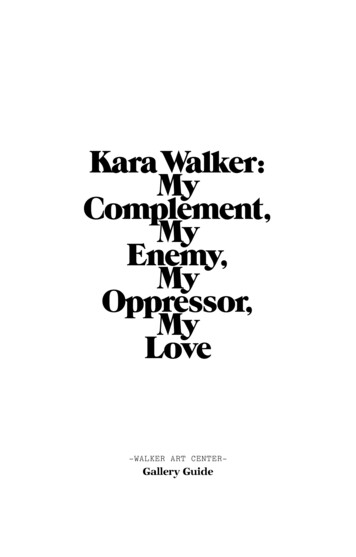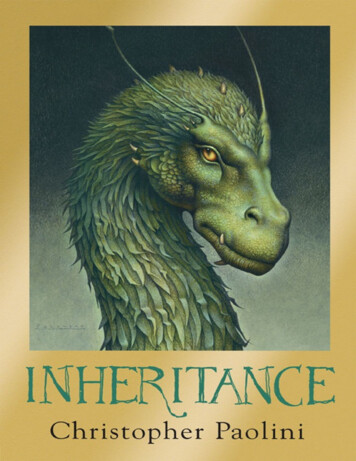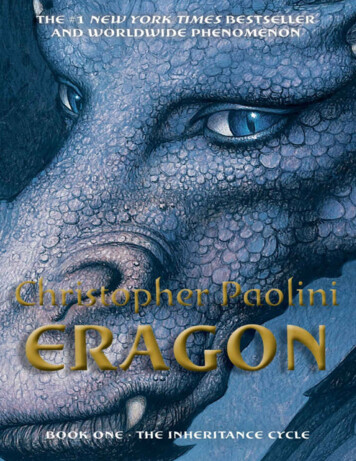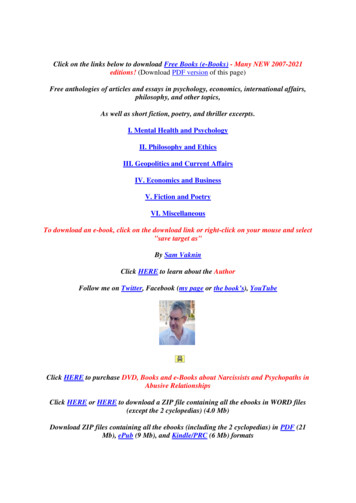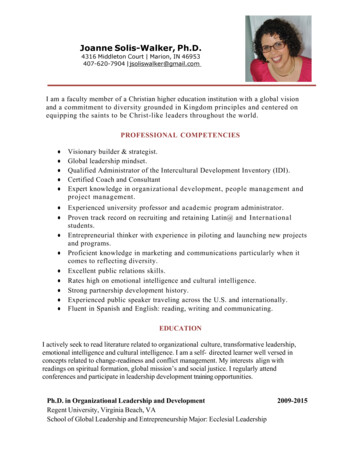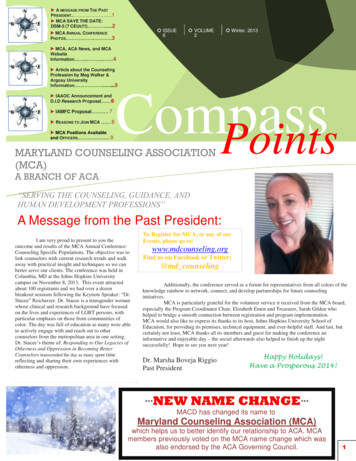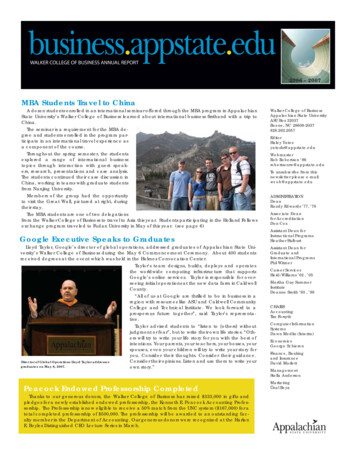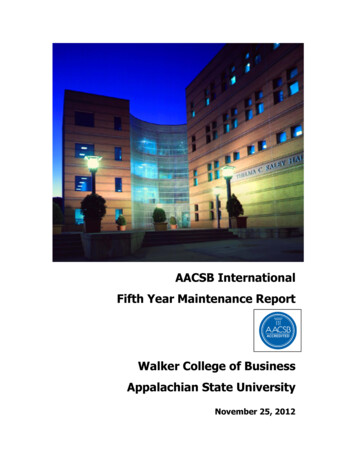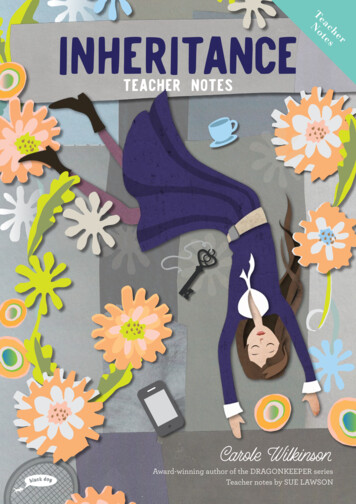
Transcription
INHERITANCETeN achot ees rsdgskjgksjgkCarole WilkinsonAward-winning author of the DRAGONKEEPER seriesTeacher notes by SUE LAWSON1
Stuck at her grandfather’s remote property, Nic searchesfor clues about her mother, who died the day she was born.But her investigation uncovers so much more than she couldhave imagined. With an inherited ability to travel back intime, Nic reveals a dark and shocking secret about theEuropean settlers and the Aboriginal owners of the land.Inheritance is compelling, shocking and based on trueevents – this is historical time-slip fiction at its best.ISBN: 97817606503602
Carole Wilkinson writes both fiction and nonfiction and her stories are loved byyoung people all over the world. Carole embarked on her writing career at the age of40 and she has been making up for lost time ever since. Her multi-award-winning andbestselling Dragonkeeper series is loved around the world.Sue Lawson is an award-winning author who also leads writing workshops for studentsand adults. She has won the Australian Family Therapists’ Award for Children’s Literatureand was short-listed for the Prime Minister’s Literary Awards and the Children’sBook Council of Australia Book of the Year Awards. Her recent titles include Nganga:Aboriginal and Torres Strait Islander Words and Phrases (with Aunty Fay Muir), FreedomRide and Our Stories: Protest in Australia.Inheritance, while historical, is a very differentbook for you. What attracted you to this story?I’d been thinking about writing a time travel book fora long time – about 20 years! Most of my books arehistorical, set in the past where characters know nothingabout the future – our present. Sending a present-daycharacter back in time allowed me to examine the pastthrough the eyes of a modern character with twenty-firstcentury ideas.Initially, I wanted to write a story set in the Dark Ages,which would have been somewhere in Europe. But thenI thought: most of my readers are Australian, I should bewriting about something that has more meaning to them.Reading a book called Dark Emu by Bruce Pascoe (whichis about how Aboriginal culture has been misrepresentedin the version of the history of Australia that most peopleaccept) convinced me that I had to confront the darkhistory of settlement.Can you explain how you decided on Inheritanceas a title?I spent ages trying to think up a clever title that hintedthat the book was about time travel. I came up with aboutten, but none of them hit the mark. Then my publisher,Maryann Ballantyne, suggested Inheritance. And itis perfect because it includes all of the things that Nicinherited from her ancestors besides the amazing abilityto time travel, including guilt and the desire to fix themistakes of the past.There is such a wide range of areas needingresearch – Aboriginal massacres, different periodsof time, even the concept of time travel. How didthe research compare to the Dragonkeeper series?I read about the history of time travel stories anddiscovered that the vast majority of them are abouttravelling into the future. That was something I had nointerest in! The decision to travel to the past was easy. Ina way it is what I’ve always done myself when I write. Asa writer of historical fiction, I travel into the past throughreading about history. Reading about how other writershandled the mechanics of time travel made me realise Ididn’t want it to be a random thing that Nic had no controlof, and I definitely didn’t want a time machine! I wantedher ability to time travel to be at least partially genetic.I’d been invited to schools in Western Victoria twice totalk to students and I found the landscape there veryatmospheric. With the Dragonkeeper series, I trawledthrough Chinese history looking for an ideal time to set astory, and once I’d decided on the Han Dynasty, I just read3
whatever I could find about that time to get a feel for whatlife was like, but also looking for story ideas. Although I’vebeen to China, I never went there for research purposes.I approached Inheritance the same way – I wanted to findsomething in the history of Western Victoria that actuallyhappened to be the seed of my story. When I read abouta massacre of local Aboriginal people, my first thoughtwas “obviously that’s not what I’m looking for. Tooconfronting, too controversial!” The more I thought aboutit, the more I realised that was exactly what I had to writeabout. I read everything I could find about the massacre(which wasn’t a lot). And then I did what I usually do forhistorical research – I looked for the primary sources. Inthis case that was the very few letters and diary entriesthat mentioned this awful event.So my research technique was the same, in that I readeverything I could find about the topic, and looked fororiginal documents. The difference was I could drive towhere I would set my story and wander around soakingup the atmosphere of the land as I learned about thehistory of the area.We know from your beautiful book Ten PoundPom that you emigrated from England when youwere young. How do you think this has influencedyour understanding of Australia’s early history,particularly its Indigenous history?I arrived in this country with no knowledge of any of itshistory. I didn’t go to primary school in Australia, and Ididn’t study history in secondary school, which meantthat my education gave me no foundation of knowledge ofAustralian history. I knew nothing at all about the history ofAustralia’s First Peoples. Even when I was young I had aninterest in history. I remember thinking that Australia hada short history, and there were no historical monumentsmuch older than 150 years. Then I visited an Aboriginalrock art site and learned about the tens of thousands ofyears of Aboriginal history.Inheritance confronts a shocking incident inVictoria’s history.Why do you believe it’s importantyoung people are aware of what happened?The massacre in my book is based on an actual event.It was one of many massacres of Aboriginal peoplein Victoria. Young people aren’t as ignorant about thehistory of settlement as I was at their age, but I think it’simportant that they understand the enormous cost toAboriginal people that settlement caused.Why did you decide to make the time travellerswomen?Most time travel stories have male protagonists. I’vewritten books from the point of view of men and women,4but when I started thinking about this book I’d just finisheda trilogy that had a male main character – not to mentiona whole lot of male dragons too! So I was ready to writea new female protagonist. When I’m writing a modernday main character, I prefer to write from a female pointof view. I also liked the idea of Nic’s female ancestors,who often didn’t get to make many choices in their lives,having this secret power.All books come with their problems duringcreation. What was the hardest part about writingInheritance?The whole time travel thing got much more complicatedthan I’d first envisioned. All the timey-wimey stuff of whohad already met who at each time travel event “did myhead in”! I always make a time line when I’m writing abook, but for this one I had at least four!It was very difficult to get the tone of the massacre scenesright. Inheritance is a middle-grade book, so I had to getthe balance right between depicting the event accuratelywithout making it too graphic.Perhaps the hardest thing was attempting to portrayAboriginal people, past and present, with respect fortheir culture and their history.What are you hoping readers will take away fromInheritance?I hope that they will think more about Australian historyfrom the point of view of its First Peoples. I hope thatit inspires them to embrace the complete history ofAustralia, and respect Aboriginal people as past andpresent custodians of this country.
YEAR 4YEAR 5YEAR 3ACHASSK106HUMANITIES AND SOCIAL SCIENCESInquiry and SkillsKnowledge andUnderstandingACHASSK134ACHASSK107ABORIGINAL AND TORRES STRAIT ISLANDER’S HISTORY AND CULTURESOI.1Country ure and contextResponding to literatureLiteratureExamining 604ACELT1605Creating LiteratureTexts in contextLiteracyInterpreting, analysing, evaluatingCreating CELY1705ACELY1715ACELY1697Key content descriptions have been identified from the Australian Curriculum (www.australiancurriculum.edu.au). However, this is not an exhaustive list of AustralianCurriculum content able to be addressed through studying this text. Information is current as at July 2018.5
Wondering WallVocabularyCreate a display with butcher’s paper called WonderingWall. Encourage students to add questions and thoughtsto the wall as they read the book. Alternatively, leavesticky notes and pens beneath the heading for childrento write their questions.Create an Inheritance Vocabulary page in students’workbooks where they can note any unfamiliar words.After reading, share, discuss and investigate words.Discussion - KWLCreate an Inheritance Word Wall to record vocabularyspecific to Inheritance and the word’s meaning.Create a KWL worksheet in student’s books, ordistribute the Inheritance KWL work sheet. (available atbit.ly/inheritanceTN)Ask children to complete the K column – What I KnowAbout Aboriginal Culture and the Colonisation ofAustralia. Once this is completed, conduct a classdiscussion about what students know and what they wantto know.Suggested discussion prompts: What do you know about Aboriginal peopleand culture? What are clans? Nations? What clans lived in this region? What do you know of their culture and lifestyle? What do you know about the relationshipsbetween Aboriginal people and Europeansduring the early years of white settlement? What do you know about Aboriginal peopletoday?Word WallFor example: squatter homestead hillocks conical liberty gloaming, etc.SettingThe Mitchell homestead is called Yaratgil. In groups, havechildren investigate the word Yaratgil and compare theirfindings. Who do you think named it? Why do you think they chose that name? Revisit the property name halfway through thenovel and again at the end. How has your viewof the name changed as the past is revealed inthe story?Children return to KWL and complete what they want toknow.Questions can be also added to the Wondering Wall.1839 ElspethThe BookWhat clues are there, apart from the chapter title, whichshow when this passage is set?Examine the book before reading. What does its title imply? What does the cover imagery and colourscheme suggest? Discuss what may be thesignificance of the girl’s clothes, the mobilephone, key and flowers. Discuss the blurb. What do you think this storywill be about? Does this change your ideasabout the cover? Discuss “dark secret”. What is a dark secret?What could this secret be? Add any questions to the Wondering Wall.Elspeth “fancies she can smell blood” (page 8). What doyou think could have happened?Elspeth cares for the horse after William has gone inside.What does this suggest about her role in the family?Why do you think Carole Wilkinson chose to start hernovel with this chapter?Chapter OneWhat do you think Nic means when she says, “a lot ofthings at Yaratgil were broken”? (page 13)Discuss Nic’s first description of Yaratgil (pages 9–10).Why might the homestead be in disrepair? What doesthe state of Yaratgil suggest about Grandad?6
Chapter TwoChapter SixNic searches Yaratgil inside and out in the first twochapters. What do you think she’s really searching for?Nic discovers Aboriginal people ate the roots of yamdaisies, but these were nearly wiped out by sheep (page59). Why do you think the sheep might have wiped outthe daisies? What would that mean for the Aboriginalpeople?Think of your own grandparents’ homes. Do theyhave photos of your parents as children and othermemorabilia? Why do you think Nic can’t find any traceof her mum at Yaratgil?Nic lists her plan for her time at Yaratgil (page 23). Doyou think this list is realistic? Why/Why not?Chapter ThreeExamine Nic’s list of Things I’ve Learned About NewSchools (page 30). Do you think this is true of yourschool? Is there anything you could do to change any ofthe items on the list?Thor dismisses Nic with the words “You’re a Mitchell”(page 31). What does that imply about Nic’s family? Doyou judge people on their family? Is this a fair thing todo? Why might the Mitchells be unpopular?This technique is called foreshadowing. Investigate thetechnique. What do you think this passage is preparingthe reader for?How is Thor different from other students? Why do youthink he was the first to speak to Nic?Do you think Thor’s explanation (page 37) is a goodenough reason for people not to like Nic?Authors use everyday items as symbols. What do youthink the key symbolises? Who do you think threw thekey into Lake Weeranganuk?Why do you think the plants had taken over the room?Chapter FourNic describes her dad as “a bit of a hippy” (page 41).What examples are there so far that support Nic’s theory?Nic’s dad’s favourite saying is “everything happens for areason” (page 41). What do you think this saying means?Do you agree with Nic? Is the saying “fake wisdom”?Chapter FiveGiven the descriptions of the land, the plants and thechild, what time do you think Nic travelled to?Who do you think the white child could be?1770 MoontineChapter SevenWhen Elspeth sees Nic she says, “You are here at last,Veronica” (page 65). Do you agree with Ronny, who tells
Inheritance is a middle-grade book, so I had to get the balance right between depicting the event accurately without making it too graphic. Perhaps the hardest thing was attempting to portray Aboriginal people, past and present, with respect for their culture and their history. What are you hoping readers will take away from Inheritance? I hope that they will think more about Australian .

